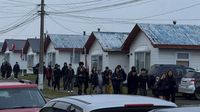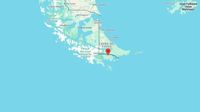On May 2, 2025, a powerful earthquake measuring 7.5 on the Richter scale struck the southern region of Magallanes in Chile, triggering a tsunami alert that affected both Chilean and Argentine coastal areas. The earthquake, which occurred at 8:58 AM local time, was centered approximately 218 kilometers south of Puerto Williams, the southernmost city in the world, at a depth of 10 kilometers. This seismic event prompted immediate evacuation alerts across the entire coastline of the Strait of Magellan, including major cities like Punta Arenas and the Chilean Antarctic territory.
The Servicio Hidrográfico y Oceanográfico de la Armada (SHOA) of Chile was quick to respond, issuing a tsunami alert shortly after the earthquake. The National Disaster Prevention and Response Service (Senapred) called for the evacuation of beach areas in the Antarctic Territory and established a precautionary state for the coastal regions. President Gabriel Boric, who was born in Punta Arenas, suspended his scheduled activities to monitor the situation from La Moneda, the presidential palace. In a message on social media, he urged citizens to heed the authorities' instructions: "We call for the evacuation of the coastal edge in the entire Magallanes Region. Our duty now is to prevent and listen to the authorities," he stated.
As the day progressed, the earthquake's impact was felt not only in Chile but also across the border in Argentina, where authorities in the province of Tierra del Fuego ordered preventive evacuations along the coast. Local officials reported that no significant damage or injuries had been recorded in either country, which was a relief amid the chaos. Alicia Cebrián López, the director of Senapred, later confirmed that the possibility of a new tsunami had been canceled, allowing those evacuated to return home, although the region of Magallanes remained under precaution.
Following the initial quake, several aftershocks were recorded, including one measuring 6.1 that struck just minutes later, further rattling the region. The first aftershock occurred nearly ten minutes after the main quake, while additional tremors continued throughout the morning. The United States Geological Survey (USGS) confirmed that at least 19 aftershocks had been documented, with varying magnitudes, indicating the ongoing seismic activity in the area.
Despite the unsettling nature of the events, reports from the National Seismological Center (CSN) indicated that the initial quake and its aftershocks did not lead to any material damage or casualties. Local authorities maintained a vigilant watch over the coastal areas, monitoring for any unusual sea level changes as the population evacuated calmly and systematically.
In the Antarctic region, minor increases in sea level were noted at the Prat and Ukrainian bases, measuring six and 23 centimeters respectively, which were classified as "instrumental tsunamis." This indicated that while the tsunami threat had subsided, the effects of the seismic activity were still being felt in the region.
As the tsunami alert was lifted, Juan Carlos Andrade, the director of disaster management in Magallanes, announced that normal activities could resume, except for economic activities along the coast. He emphasized that while the evacuation was over, precautions were still necessary as the region remained on alert for potential aftershocks.
In Argentina, the local authorities in Ushuaia reported no significant damages or evacuations, which was encouraging given the circumstances. The Civil Protection Secretariat of Tierra del Fuego also announced a temporary halt to all aquatic and navigation activities in the Beagle Channel, ensuring the safety of residents and visitors alike.
Throughout the day, President Boric and his administration coordinated with various disaster response committees to manage the emergency effectively. The president assured the public that all state resources were available to address the situation and support affected communities.
As of the latest reports, the situation appeared to be stabilizing, with citizens returning to their daily routines and authorities continuing to monitor the region for any signs of further seismic activity. The quick response from emergency services and the cooperation of the public in adhering to evacuation orders played a crucial role in minimizing the potential impact of the earthquake and tsunami threat.
While the immediate crisis may have passed, the events of May 2 serve as a stark reminder of the geological volatility of the region and the importance of preparedness in the face of natural disasters. The people of Magallanes and Tierra del Fuego, having experienced the tremors of the earth and the threat of the sea, now look forward to a return to normalcy, ever aware of the forces that shape their environment.






